
On Instagram and other social media platforms, it’s easy to aspire to colossal goals when you’re scrolling through complicated poses that require balance, flexibility and extensive contortions. But before jumping right into difficult yoga poses at home, it’s key to start with the basics, learn the proper techniques and know your limits. Sun Salutations are often referenced as a beneficial tool, and they are popular for first-time students.
According to yoga instructor Lindsey Argo of Sangha Studio, who teaches Vinyasa and Yin Yoga courses, it is important to take classes or use expert tutorials when you are first starting out.
“If you form bad habits, they can be tough to break,” Argo said. “Sun Salutations warm the body before intense practice, loosen tense muscles and energize. Traditionally, you would go out early in the morning, down by the riverbank and do them while the sun was coming up.”
In the Vinyasa style, these salutes help link the poses together in a moving meditation. Synchronization allows one pose to flow into the next, while breathing techniques bridge the motions.
Three warm-up options are available:
- Classic Sun Salute
- Sun Salute A
- Sun Salute B
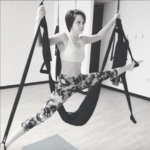
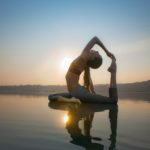
The Scoop sat down with Argo and Kelsey Esther, an aspiring yogi who is currently earning her teaching credentials at My Hot Yoga, to discuss Sun Salute A step by step. Each provided tips on maintaining alignment, synchronizing breath work and positioning the body correctly.
Step 1: Mountain Pose (Tadasana)
Begin by standing at the front of the mat in a straight pose with your shoulders back and gaze straight ahead, gathering the chin rearward. The shoulders are stacked over the hips. The feet should be parallel, where the toes are together and all four corners are rooted to the ground.
“It is important that the second toe is pointing forward and aligned,” Argo said. “Some may feel a little pigeon-toed, but this is the correct alignment for the stance.”
With a slow inhale, shift the arms to heart center and allow both hands to press together in front of you. In this moment, it helps to lean back for support, but it is not necessary. After anchoring the body, maneuver the arms down to your sides. The palms are flipped outward and open.
“Mountain Pose is a gesture of receiving, where people start Pranayama,” Esther said.
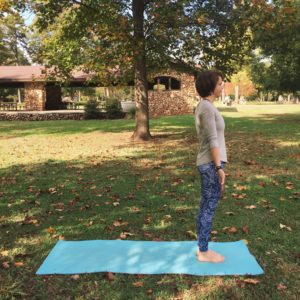
Step 2: Upward Salute (Urdhva Hastasana)
You’re now ready to dive in with an Upward Salute to pay tribute to the sun. Take advantage of your spacious lungs with a deep inhale and arrange the hands overhead in prayer, stretching the shoulders. Typically, the legs are tight and perpendicular to the floor, but you can bend at the knee to ward off unnecessary strain.
“It’s not possible for the instructor to get inside your body and tell you if it feels right or not, so you have to adapt the routine to your level with small adjustments,” Argo said. “You can take each pose at an advanced or beginner level.”
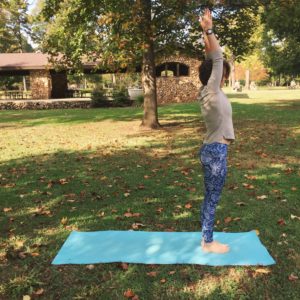
Step 3: Standing Forward Fold (Uttanasana)
Adjust the body by folding into Uttanasana with straight legs. In this move, angle forward and lengthen the back to ensure it is flat. The objective is to define space between the vertebrae, which supports proper alignment of the spine. Both hands should descend to the shins and ultimately reach the mat.
According to Argo, this act encourages students to practice patience and acceptance. They can now let go and humbly connect with their inner spirit.
“You are surrendering into yourself, but also calming the mind,” Argo said.
In terms of physical advantages, the Standing Forward Fold tones the legs and challenges core muscle groups.
“This is a calf and hamstring stretch, which targets the inner leg,” Esther said. “If you really want to feel the burn, extending the knees can help you to achieve maximum benefits.”
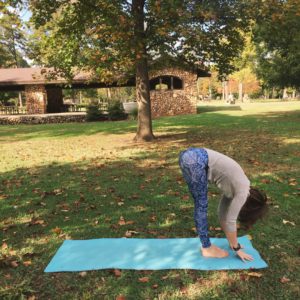
Step 4: Half-Standing Forward Fold or Half-Lift (Ardha Uttanasana)
Next, you can inhale to a Half-Lift. This fold requires that the back is horizontal, co-extending with the ground. The fingers are flexed, lying at your calves, while the abdomen is contracted.
The movement from Standing Forward Fold to Half-Lift increases joint plasticity, so you can eventually touch your toes if you duplicate the motion. Argo notes that beginners can conquer more difficult stances by prepping the body and warming up daily with this pose.
“Repetition helps develop your skill set,” Argo said. “In yoga, we are looking for balance. We don’t want too much strength or flexibility. Instead, we are looking for somewhere in the middle.”

Step 5: Four-Limbed Staff Pose (Chaturanga)
On an exhale, go into your Chaturanga or a low plank pose by shifting each leg back from a lunge position. The toes tuck vertically, the elbows tighten and the knees drift off the mat. Simultaneously, the arms press away from the floor to withstand gravity.
“The Chaturanga is similar to a push-up, which strengthens the arms and abdomen,” Esther said. “It is a core-tightening exercise and allows for balance on all four limbs.”
Metaphorically, it’s purpose is to help you become more self-assured and confident, so that you have the motivation to tackle any daunting task.
“This pose focuses on finding the strength to push yourself through a difficult time,” Argo said.
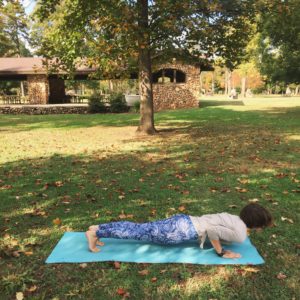
Step 6: Upward-Facing Dog (Urdhva Mukha Svanasana)
When transitioning into the Upward-Facing Dog, make certain the tops of your feet are in contact with the mat. Opening your heart space, press the hands firmly down and widen the chest. Gaze ahead with the face directed forward.
As the shoulders are drawn backwards, this movement flexes the back. You can now lower the legs, allowing for the knees and hips to slightly hover.
In many ways, this position assists with postural problems and muscle tightness, which can also be alleviated through spinal manipulation.
“I always suggest people do spinal movements, if you don’t do a lot of moving during the day,” Argo said. “You can extend, contract and twist the body to open up the sides.”
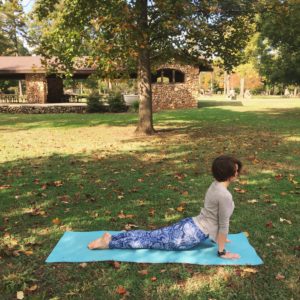
Step 7: Downward-Facing Dog (Adho Mukha Svanasana)
Next, continue to Downward-Facing Dog. Bring the soles of your feet down to the mat in full contact. To aid in balance, pull the hips upward using your core strength. The back angles downward for this resting pose and remains straight all the way through to the wrists.
At this moment, it is critical that the body’s weight is properly distributed to avoid wrist injuries.
“Wrist rolls can help to avoid strain,” Esther said, “but what you really want is all the weight to go to the thumb and forefinger. You should be able to lift up your other fingers and lift through your wrist, decreasing the amount of weight there.”
Downward-Facing Dog is especially beneficial to college students, as it provides an opportunity to destress.
“It is one of the pinnacle release poses in Sun Salutations, so if you are having emotional stress or spiritual stress, this is a good time to let go,” Argo said.
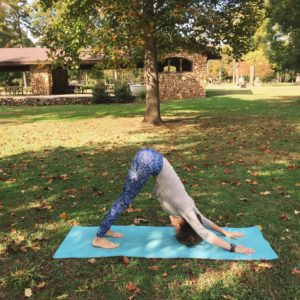
Step 8: Invert Steps 1-4
End your Sun Salutations routine by repeating steps one through four, reversing the sequence:
- Jump forward to the top of your mat into Half-Lift.
- Continue with a straight back into a Standing Forward Fold.
- Move upward with your hands overhead in Upward Salute.
- Allow yourself a reflective exhale and settle back into Mountain Pose.


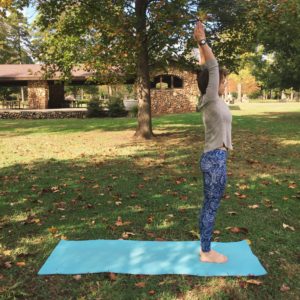
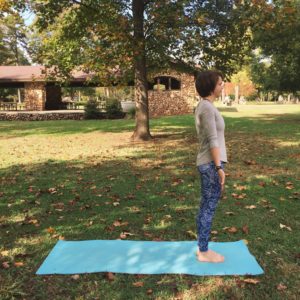
(Sun Salute Photos by Paulina Doran; Bio Photos Provided by Lindsey Argo & Kelsey Esther)